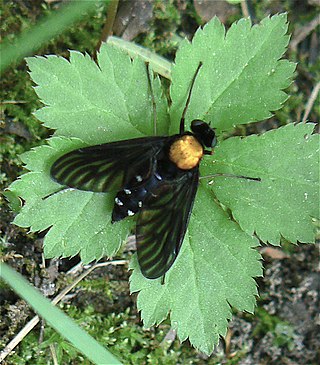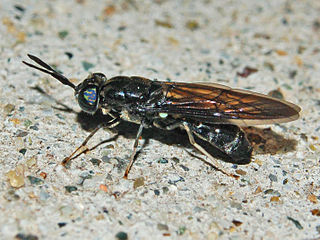
Chrysopilus is common, worldwide genus of predatory snipe flies. There are approximately 300 species in the genus, including fossil members that are sometimes found in amber.

Rhagio is a worldwide genus of predatory snipe flies. Several species in this genus are referred to as downlooker or down-looker flies because they sometimes perch on tree trunks in a head-down position. There are approximately 170 species. They can be distinguished from other rhagionids by the open anal cell on the wings and the lack of a kidney-shaped arista.

Xylota is a Holarctic genus of hoverflies similar in structure to the related genera Chalcosyrphus and Brachypalpoides. As the larvae are saprophytic they're usually found in rotting wood. The adult flies are generally associated with woodland and woodland edges and can often be seen running over the upper sides of leaves. Unlike other syrphids the adults of many species rarely visit flowers preferring instead to gather pollen from leaf surfaces. There are over 100 described species of which 12 can be found in Europe. Seven species have been recorded in Britain. Identification of species has been difficult and identifiction by photographs is risky.

Chrysosoma is a genus of flies in the family Dolichopodidae. It is a large genus, with more than 200 species distributed in the Old World and Oceania.

Chalcosyrphus is a genus of hoverflies in the subfamily Eristalinae. Many species exhibit some degree of mimicry of various sawflies and other hymenopterans and are often brightly coloured or metallic in hue. The adults are similar in structure and behavior to the related genus Xylota but differ in larval morphology. They can be found throughout Europe, Asia, and North America and seem to prefer damper, boggy habitats. The larvae are saproxylic feeders in rotten wood in these habitats.

Nephrotoma is a genus of crane flies.

Pselliophora is a genus of true crane fly.

Milesia is a genus of very large hoverflies, which mimic social wasps. For example, the European species Milesia crabroniformis is a convincing mimic of the hornet species Vespa crabro. Milesia are predominantly Palaeotropical in distribution almost entirely Oriental.

Oxycera is a genus of soldier flies in the family Stratiomyidae. There are at least 80 described species in Oxycera.

Clitellaria is a genus of flies in the family Stratiomyidae.

Hermetia is a genus of flies of the family Stratiomyidae.

Solva is a fly genus in the family Xylomyidae, the "wood soldier flies".

Cyphomyia is a genus of flies in the subfamily Clitellariinae.

Acrocera is a genus of small-headed flies in the family Acroceridae.

Adoxomyia is a genus of soldier flies in the family Stratiomyidae.

Sylvicola is a genus of wood gnats in the family Anisopodidae. There are more than 80 described species in Sylvicola.

Allognosta is a genus of soldier flies in the family Stratiomyidae.
Suragina is a genus of flies in the family Athericidae.
Chrysochlora is a genus of flies in the family Stratiomyidae.
















